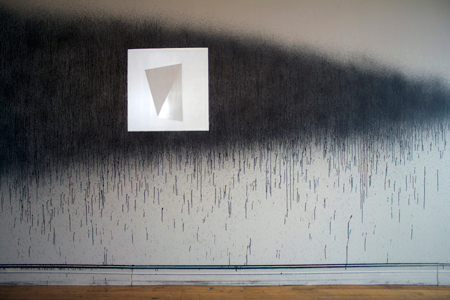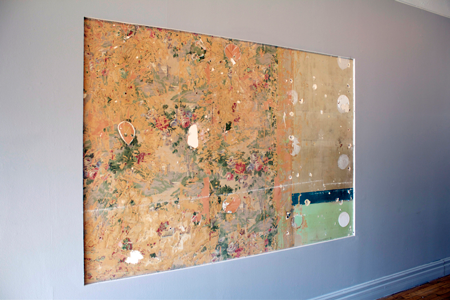Clayton Windatt
All images by and courtesy of the artist.
Does paint dream of Jinny Yu and itself become?
Jinny Yu challenges more than the concept of painting. Her work challenges the existence of predisposed artistic practices as she blurs the lines between methodology to ideology through her exploration of the concept of painting. This redefining of the context of painting changes the way we look at painting as an art form but more importantly the way we envision art creation processes in general.
Yu has been working within the Canadian and international art scene since the late 1990’s. Her work leading up to 2008 dealt with complex abstraction in painting resulting in a series of works dealing with the concept of space in relation to practice specifically discussing nomadic behaviour.[1] These earlier paintings indulging the notion of artist as a migratory being with the ability to shift between contexts and identities resulted in vibrant colourful works that conveyed a calculated approach mimicking architectural form, computer circuitry and creating a rich aesthetic to carry her message. This work referring to nomadic patterns, movements’ and routines whose boundaries were defined through canvas edges drew the interest of many of Canada’s theoretical art writers and received a flux of attention. Since 2008 Yu’s work has become steadily different in its approach and in the resulting exhibitions. Yu focused more and more on utilizing aluminum as a support or starting point for creation investigating the prospective intrinsic to aluminum allowing vivid expression to occur naturally exemplifying depth of field. Limiting the colour palette to black paint on aluminum was a departure from previous works and over time Yu has abandoned conventional aesthetics and moved steadily towards analyzing and critiquing the concepts associated with her chosen practice. Yu’s questioning the theories imbued within the established norms of contemporary painting has resulted in the emergence of more challenging works.

From the Superstack, Sudbury, 2013, ink on wall, 103 x 312 inches, and Bent in Motion, 2012, 16mm transferred on HD, colour, sound, 2 feet 29 inches, camera: Irina Lyubchenko, sound: Jung Hun Yoo.
Boldness is something that Canada needs more of as our culture and status within global circles leaves most wanting. Our arts scene can be viewed as overly Canadian focused as well as our funding systems. Canada is constantly changing and exploring national identity which affects public projection portraying a lack of confidence as a nation. This does not affect Yu’s work however, as she finds Canada’s continuous renegotiation of its own identity parallels her practice in many ways. Canada has aided in the development of Yu’s artistic identity as the country’s self reflection encourages her own. This questioning is constant within all contemporary art circles as searching for the boundaries and parameters of an art form is a natural progression. Although reflection is a constant within the arts milieu of Canada both by individual and artistic infrastructures alike, it is uncommon for an individual to reflect not on their practice or their work but on the concept of what their practice means and entails. Artist-Run Centres (ARCs) are the proving grounds for experimentation and innovation within the arts as often works have little to no commercial intention when created and the venue allows for critical public view without the same hang-ups or profit based demands of museums or commercial galleries. In recent years an influx of critical experimentation has arisen in which art spaces themselves are critiquing their own existence and questioning the reasons for their being. ARCs have been debating the methodology of their operations and challenging the concept of institutionalization which seems to be inherent with incorporated entities. The “Institutions by Artists” conference that took place in Vancouver in the fall of 2012 aided in publicly establishing these issues and the “East of There” conference in Saint John brought these conversations towards solutions specifically within the realm of publishing. In any case, the reason why it is relevant connecting Jinny Yu to Artist-Run culture is more about the uniqueness she has in adapting her practice ahead of others. When industries start to challenge specifics and question things it is a pattern of behavior that echoes into the arts practices of all that are impacted by those industries. There are parallels with current ARCs’ conversations that question how institutionalization and corporate conformity might be challenged by the ideologies underlying chosen artistic methodologies. The only revelation is that Yu’s questioning of her practice started 5 years before ARCs’ have been debating the methodology of their operations.

Non-Painting Painting, 2012, oil on aluminum, 23.5 x 19 x 19 inches.
It is no wonder though that Yu’s recent exhibition “i am painting” was held at the Sudbury based ARC, La Galerie du Nouvel-Ontario (GNO). This being the newest revelation in Yu’s career as it takes things farther with her conceptual theory regarding paint brought into existence through practice. A quote from the exhibition statement summarizes “Jinny Yu’s work investigates the very nature of painting. […] There is no effort to hide the artist’s particular movements; the marks left by her work proudly betray the movements of the brush across the surface. Rather, she seeks to reveal and underline the properties of her favoured material.”[2] Yu has employed the complete immersion of her work utilizing video as well as altering the building’s structure itself probing and exploring the realm of space, concept and medium cutting and mending as she goes. To unprepared viewers this exhibition might lead them to believe they are entering a multi-disciplinary artist’s installation. The work installed is painted directly onto the walls with a magnitude of detail that at first seems random but upon closer inspection has the obvious intention and a potential to leave you trying to find more purposeful connections. There is a temptation to look for meaning beyond the artist’s intentions with this installation as previous work indicates reasoning behind the patterns in works. Additionally there is a unity to the entire show that makes you feel as though everything was meticulously planned before creation began. The video installed projecting on the wall opposite to the cut hole implies premeditated mastery or at least a happy accident. The entire series of works allows for people to follow the reasoning of the process through as there are indicators that bring the viewer towards a conclusion without the use of didactic texts. A piece in the corner employs the reflective quality of aluminum to show a box within a box painted across two surfaces. The obvious meanings that one can find within works are elusive and perhaps instead are closely tied to the employment of the medium. The subject of whether or not this is painting is where the real challenges take place as the viewer struggles with conceptual content and not aesthetics. The work installed becomes painting even with pieces lacking paint. A cut slab from the GNO space reveals old painted walls, wallpaper and the absolute age of a building that has been repainted and renovated dozens of times over a span of decades. This piece has become a painting as with all Yu’s works. Her practice takes the form of complete abstraction considering the proclamation of self identified painting even though there is no paint within the work itself. This is not the first time Yu has created paintings without using paints, but her practice has become more aggressive in its mannerisms and with the boldness with which she applies this concept.[3]

I am Painting, 2013, opening of the wall, 56 x 80 inches.
Yu is a painter; I say that she is a painter because she has proclaimed her act of creating as “painting”. Although she may be using oil paints and brushes for the majority of her work, the act itself has become more of an analysis of states of being. She is using creation as a way to evaluate the creation process and questions the act as it takes place. She makes subtle changes to the ways she creates, as any other painter or artist, ensuring that works evolve in her career and that the resulting pieces are matching the desired aesthetic of her current artistic statement. Yu is conscious of her process in painting as she explores conceptual theory about what painting means and all the things that comes with the idea of paint. This course of action brings the surrounding world of Yu’s life into this procedure as with all artists during creation. Influences and instinct contribute in each piece becoming a glimpse of a new state of consciousness that results from the creation process. These creations are not mere by-products of an act, Yu challenges paint as practice and as a way to bring new paintings into existence.
Jinny Yu has made a career from pushing boundaries or just leaving them behind as she moves forward. The norms within the contemporary painting world are not relevant to her practice, she finds her own meaning within paint through process and the concept of action. For Yu, painting represents a metaphor for existence within a world and addresses the current socio-political roles of that world whether represented visually or not. Each piece is its own glimpse of an existence and time giving her audience a sample of place, state and thought in painting. Yu’s work continues to be forward-thinking and evolutionary in its development leading me to question where things go next. How advanced can painting become, and what ways can the challenges of a given arts practice become so innovative that they question the very act of painting?
[1] “Story of a Global Nomad” by Michael Rattray, http://artmur.com/en/artists/jinny-yu/story-of-a-global-nomad/
[2] “i am painting” by Daniel Aubin, http://gn-o.org/node/3281
[3] “Jinny Yu” by Michael Rattray, Border Crossings, no. 125, March 2013, pp. 85-87
Born in Korea and based in Canada and Italy, Jinny Yu‘s work has been shown widely, including exhibitions at the ISCP Gallery (Brooklyn), Pulse New York (NY), Scope New York (NY), Bevilacqua La Masa Foundation (Venice), Kunst Doc Art Gallery (Seoul), the Kyoto Municipal Museum of Art (Kyoto), the Conduit Street Gallery, Sotheby’s (London), Carleton University Art Gallery (Ottawa), the Confederation Centre Art Gallery (Charlottetown), and McMaster Museum of Art (Hamilton). Yu, who is Associate Professor of Painting at the University of Ottawa, was awarded the Mid-Career Artist Award by Council for the Arts in Ottawa in 2013; Laura Ciruls Painting Award from Ontario Arts Foundation in 2012; and was a finalist for the Pulse Prize New York 2011. She has received grants from the Canada Council for the Arts, Ontario Arts Council, and le Conseil des Arts et des Lettres du Quebec. She is represented by Galerie Art Mur in Montreal and General Hardware Contemporary in Toronto.
Born in St. Catherines, Clayton Windatt has lived in the Northern Ontario region for almost his entire life. He is a Métis arts administrator currently working as Director at the White Water Gallery in North Bay, Ontario. Clayton holds a BA in Fine Art from Nipissing University and received his Graphic Design certification from Canadore College. He works actively with several arts organizations locally, provincially and nationally on committees and boards of directors.
Clayton also maintains contracted positions with Canadore College’s REP21 theatre program and works as a columnist for the North Bay Nipissing Newsproducing a weekly arts column for the Nipissing District. He aids in local arts activities and administration through Aanmitaagzi and their different community arts events and founded the Active Arts Festival. He contributes actively as a writer, designer, curator, performer and theatre technician and is an active visual and media artist.